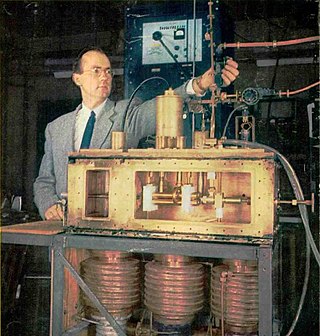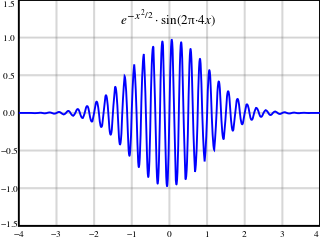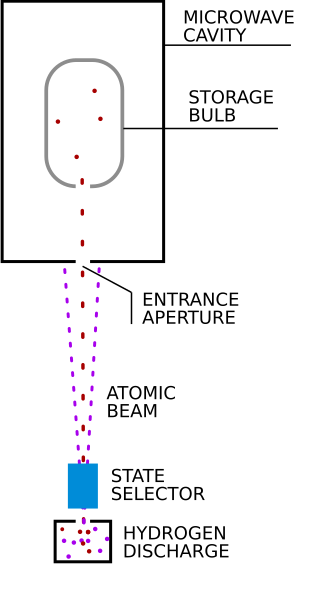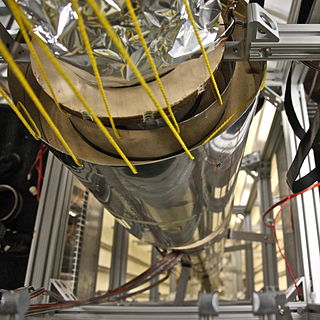International Atomic Time is a high-precision atomic coordinate time standard based on the notional passage of proper time on Earth's geoid. TAI is a weighted average of the time kept by over 450 atomic clocks in over 80 national laboratories worldwide. It is a continuous scale of time, without leap seconds, and it is the principal realisation of Terrestrial Time. It is the basis for Coordinated Universal Time (UTC), which is used for civil timekeeping all over the Earth's surface and which has leap seconds.

The hertz is the unit of frequency in the International System of Units (SI), equivalent to one event per second. The hertz is an SI derived unit whose expression in terms of SI base units is s−1, meaning that one hertz is the reciprocal of one second. It is named after Heinrich Rudolf Hertz (1857–1894), the first person to provide conclusive proof of the existence of electromagnetic waves. Hertz are commonly expressed in multiples: kilohertz (kHz), megahertz (MHz), gigahertz (GHz), terahertz (THz).

A maser is a device that produces coherent electromagnetic waves (microwaves), through amplification by stimulated emission. The term is an acronym for microwave amplification by stimulated emission of radiation. First suggested by Joseph Weber, The first maser was built by Charles H. Townes, James P. Gordon, and Herbert J. Zeiger at Columbia University in 1953. Townes, Nikolay Basov and Alexander Prokhorov were awarded the 1964 Nobel Prize in Physics for theoretical work leading to the maser. Masers are used as the timekeeping device in atomic clocks, and as extremely low-noise microwave amplifiers in radio telescopes and deep-space spacecraft communication ground stations.

The second is the unit of time in the International System of Units (SI), historically defined as 1⁄86400 of a day – this factor derived from the division of the day first into 24 hours, then to 60 minutes and finally to 60 seconds each. "Minute" comes from the Latin pars minuta prima, meaning "first small part", and "second" comes from the pars minuta secunda, "second small part".
The Primary Atomic Reference Clock in Space or PARCS was an atomic-clock mission scheduled to fly on the International Space Station (ISS) in 2008, but cancelled to make way for the Vision for Space Exploration. The mission, to have been funded by NASA, involved a laser-cooled caesium atomic clock, and a time-transfer system using Global Positioning System (GPS) satellites. PARCS was to fly concurrently with the Superconducting Microwave Oscillator (SUMO) a different type of clock that was to be compared against the PARCS clock to test certain theories. The objectives of the mission were to have been:

A Kibble balance is an electromechanical measuring instrument that measures the weight of a test object very precisely by the electric current and voltage needed to produce a compensating force. It is a metrological instrument that can realize the definition of the kilogram unit of mass based on fundamental constants.
Resolved sideband cooling is a laser cooling technique allowing cooling of tightly bound atoms and ions beyond the Doppler cooling limit, potentially to their motional ground state. Aside from the curiosity of having a particle at zero point energy, such preparation of a particle in a definite state with high probability (initialization) is an essential part of state manipulation experiments in quantum optics and quantum computing.

The history of watches began in 16th-century Europe, where watches evolved from portable spring-driven clocks, which first appeared in the 15th century.

A frequency comb or spectral comb is a spectrum made of discrete and regularly spaced spectral lines. In optics, a frequency comb can be generated by certain laser sources.

A chip scale atomic clock (CSAC) is a compact, low-power atomic clock fabricated using techniques of microelectromechanical systems (MEMS) and incorporating a low-power semiconductor laser as the light source. The first CSAC physics package was demonstrated at NIST in 2003, based on an invention made in 2001. The work was funded by the US Department of Defense's Defense Advanced Research Projects Agency (DARPA) with the goal of developing a microchip-sized atomic clock for use in portable equipment. In military equipment it is expected to provide improved location and battlespace situational awareness for dismounted soldiers when the global positioning system is not available, but many civilian applications are also envisioned. Commercial manufacturing of these atomic clocks began in 2011. The CSAC, the world's smallest atomic clock, is 4 x 3.5 x 1 cm in size, weighs 35 grams, consumes only 115 mW of power, and can keep time to within 100 microseconds per day after several years of operation. A more stable design based on the vibration of rubidium atoms was demonstrated by NIST in 2019. The new design has yet to be commercialized.

NIST-F2 is a caesium fountain atomic clock that, along with NIST-F1, serves as the United States' primary time and frequency standard. NIST-F2 was brought online on 3 April 2014.

A hydrogen maser, also known as hydrogen frequency standard, is a specific type of maser that uses the intrinsic properties of the hydrogen atom to serve as a precision frequency reference.

An atomic fountain is a cloud of atoms that is tossed upwards in the Earth's gravitational field by lasers. If it were visible, it would resemble the water in a fountain. While in free-fall, the atoms are measured to set the frequency of an atomic clock.

In physics, time is defined by its measurement: time is what a clock reads. In classical, non-relativistic physics, it is a scalar quantity and, like length, mass, and charge, is usually described as a fundamental quantity. Time can be combined mathematically with other physical quantities to derive other concepts such as motion, kinetic energy and time-dependent fields. Timekeeping is a complex of technological and scientific issues, and part of the foundation of recordkeeping.

An atomic clock is a clock that measures time by monitoring the resonant frequency of atoms. It is based on atoms having different energy levels. Electron states in an atom are associated with different energy levels, and in transitions between such states they interact with a very specific frequency of electromagnetic radiation. This phenomenon serves as the basis for the International System of Units' (SI) definition of a second:
The second, symbol s, is the SI unit of time. It is defined by taking the fixed numerical value of the caesium frequency, , the unperturbed ground-state hyperfine transition frequency of the caesium-133 atom, to be 9192631770 when expressed in the unit Hz, which is equal to s−1.
A quantum clock is a type of atomic clock with laser cooled single ions confined together in an electromagnetic ion trap. Developed in 2010 by physicists at the U.S. National Institute of Standards and Technology, the clock was 37 times more precise than the then-existing international standard. The quantum logic clock is based on an aluminium spectroscopy ion with a logic atom.
Leonard Cutler (1928–2006), also known as Leonard S. Cutler, was a pioneer and authority on ultra-precise timekeeping devices and standards, and was well known for his work with quantum-mechanical effects. He was the co-inventor of the HP5060A Cesium Beam Clock, its successor the HP 5071A, and the two-frequency laser inferometer. He has also been praised for his crucial contributions to the design of the Allen Telescope Array.
The Dick effect is an important limitation to frequency stability for modern atomic clocks such as atomic fountains and optical lattice clocks. It is an aliasing effect: High frequency noise in a required local oscillator (LO) is aliased (heterodyned) to near zero frequency by a periodic interrogation process that locks the frequency of the LO to that of the atoms. The noise mimics and adds to the clock's inherent statistical instability, which is determined by the number of atoms or photons available. In so doing, the effect degrades the stability of the atomic clock and places new and stringent demands on LO performance.

Tara Michele Fortier is a Canadian physicist and Project Leader in the Time and Frequency Division at National Institute of Standards and Technology. Her research considers precision optical and microwave metrology. She was elected Fellow of the American Physical Society in 2022 and awarded the SPIE Harold E. Edgerton Award in High-Speed Optics in 2023.












